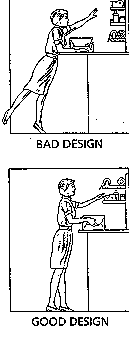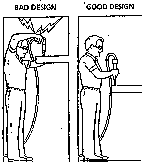ERGONOMICS
How to change your workplace, work station,
equipment, tools and work
organization to reduce
injuries and discomfort and improve your well-being.
WHAT KINDS OF WORKPLACES CAN BE IMPROVED BY THE USE OF ERGONOMICS?
Auto and truck assembly plants, parts plants, trains and rail shops, aerospace plants, telecommunications plants, electronics assembly plants, foundries, fish plants, airline terminals, offices, retail stores, mines, fishing vessels, trucks, hotels and restaurants.
In short, wherever CAW members work.
WHAT IS ERGONOMICS?
Ergonomics means changing the workplace, work station, equipment, tools and work organization to meet the needs of the worker, rather than having the worker adjust to the work.
People come in all sorts of shapes and sizes. We need to ensure where we work and what we work with are changed to meet our needs. People with disabilities need us to meet their needs too.
Think about your job. How could it be changed to make your work easier and more comfortable?
The following are a few ideas to use ergonomic principles to prevent injuries and improve your well-being.
Discuss your ideas with your CAW workplace health and safety representative. You rep can advise you on ergonomics and can fight to get your work changed.
HOW CAN TOOLS AND EQUIPMENT BE CHANGED?
Tools and equipment should be designed to keep hands and wrists in the same position as they would be if they were hanging relaxed at your side.
Look at this example of good knife design. The wrist is straight and the knife is bent.

Use tools that fit your hand. If the tool's hand grip is too large or too small, it will be uncomfortable and produce injury after repeated use.
REDUCE REACHING
Jobs and work stations should be designed so arms are not raised above shoulder height on a regular basis. Keep your arms low and shoulders close to your body.

REDUCE REPETITION
Some jobs must be mechanized to reduce RSIs (repetitive strain injuries). Here's one example:
- Use power driven screwdrivers instead of ordinary screwdrivers. Ensure the power screwdriver does not wrench your hand from too much torque. Ensure it is a straight design so your wrist remains straight.

SLOW DOWN
Some employers want you to work too fast or too hard. If you do, you will likely get an RSI.
Protect yourself. You have the right to refuse work which is likely to hurt you. Talk to your Health & Safety rep.
PREVENT BACK INJURIES
Don't lift things that are too heavy. Tell your employer that you need a lifting device such as a forklift or hoist. In the meantime, get help when lifting heavy things.
Your job or work station needs to be changed so you do not have to twist when lifting heavy objects. Even if you are moving light things, twisting rapidly or often is bad for your back.
You need shelves, work tables or bins so you do not have to move objects at floor height.
For More Information
You can find out more about the injuries ergonomics should protect, in the CAW short brochures about RSIs and back injuries.
You can find out a lot more about ergonomics, RSIs and back injuries by reading our 44-page publication CAW Ergonomics in the Work Environment, a Manual for Workers.
The brochures and the manual are available from your workplace CAW reps or write, phone or fax:
CAW Health and Safety Department
205 Placer Court, North York,
Ontario, M2H 3H9
tel: (416)495-6558 or 1-800-268-5763
fax: (416)495-6554
 Click on our logo to return to the CAW Digital Collections Home Page
Click on our logo to return to the CAW Digital Collections Home Page